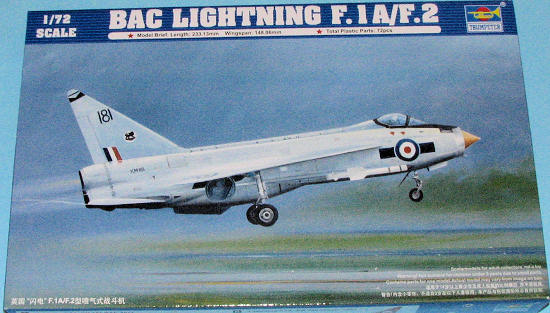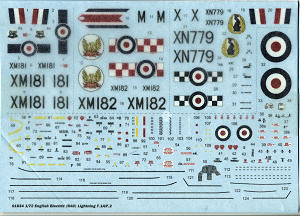
| KIT #: | 01634 |
| PRICE: | $37.00 SRP |
| DECALS: | Three options |
| REVIEWER: | Scott Van Aken |
| NOTES: | New Mold kit |

| HISTORY |
The last supersonic single seat fighter developed by the British and put into unit service was the BAC/E.E. Lightning. Though not built in large numbers, the type has etched itself into the consciousness of aviation fans all throughout the UK. A maintenance nightmare according to those who worked on it, the aircraft was, nevertheless, quite capable and extremely fast. In fact, its speed was a major plus for an interceptor in the UK when the warning time was minimal. It was also quite fuel thirsty and was often seen with its somewhat unique over-wing fuel tanks. This odd arrangement has been used on a few other aircraft for weapons, but to my knowledge, no other aircraft has routinely carried them in this fashion. Though the type was withdrawn from service in the late 1980s, several still operate in the UK doing fast taxy demonstrations and I believe at least one is airworthy in South Africa. The British aviation authorities will not allow private flying of the Lightning due to the ease at which the control surface hydraulic lines could easily be switched by accident and the lack of manual back-up. Then there is the problem with general maintenance, but the flight control deal that has kept them grounded.
| THE KIT |
 To date, there have been Lightning kits developed by Airfix, Matchbox, and Hasegawa in 1/72 scale along with a few vac conversions, a resin kit or two and the inevitable reboxing. Frog reboxed the Hasegawa kit for their line and Airfix modified their F.1 kit to F.3 standards about ten years or so ago. This is an all new tooling from Trumpeter for the F.1A/F.2 variant and I have to say that it looks like they did things right. Now Lightning advocates will undoubtedly be scrutinizing things for glitches, but it looks fine to me. At about the same time, an F.2A/F.6 was released and so there are common sprues between the two.
To date, there have been Lightning kits developed by Airfix, Matchbox, and Hasegawa in 1/72 scale along with a few vac conversions, a resin kit or two and the inevitable reboxing. Frog reboxed the Hasegawa kit for their line and Airfix modified their F.1 kit to F.3 standards about ten years or so ago. This is an all new tooling from Trumpeter for the F.1A/F.2 variant and I have to say that it looks like they did things right. Now Lightning advocates will undoubtedly be scrutinizing things for glitches, but it looks fine to me. At about the same time, an F.2A/F.6 was released and so there are common sprues between the two.
The kit has a convincing tub with a fair bang seat. I know that Pavla make replacements for these if you want greater detail. The intake assembly reminds me much of the Airfix 1/48 kit and that is good. It means that one can wait until the end of assembly to install the nose cone so that one is sure of the ability to install nose weight. None is indicated in the instructions, but I'd rather have the option to install it. Other similarities to the Airfix 1/48 kit are the inserts for the gun muzzles or blanking plates, separate flaps as well as separate speed brakes and canopy sections.
The kit offers both Firestreak and Redtop missiles (the Firestreaks being molded in clear). However, I believe that the F.1 and F.2 aircraft (and variants) carried the Firestreak, while the F.3 and F.6 versions used the Redtop. Trumpeter's instructions also show that the blanking plates you use for the nose are optional. They are not and it would be well advised to check your references before adding in these pieces. As on every small scale Lightning kit I've built, the nose wheel and leg are a single construct. The main gear appear good and sturdy, but the Lightning is a 'spindly geared' aircraft. I dif find that most of the inside of the gear doors and the speed brakes had ejector pin  marks that you'll have to remove if you want this to be a contest plane.
marks that you'll have to remove if you want this to be a contest plane.
Instructions are quite well done, but as I mentioned, they provide options without indicating which is for the F.1 and which for the F.2. As usual, a variety of paint references. There are markings for three aircraft supplied, all in unpainted metal. The full color placement guide provides no unit or variant information at all. The box side does identify #19 and #56 squadron and the variants used, but leaves the third option as 'RAF'. I believe this to be some sort of training flight or Target Flight, but don't know for sure. Decals are well printed and one also has a number of aftermarket options including a plethora of older ModelDecal sheets. Model Alliance has also done an early Lightning sheet, but as I've not had one for review, cannot provide any information regarding it. Be sure that most units will be covered in the next year or so.
| CONCLUSIONS |
So there you have it. Not to sound trite, but this does make your other kits obsolete in terms of detailing and probably ease of assembly. If you still have your Airfix Lightning F.1, which was not the easiest kit to build and suffered from some shape inaccuracies, especially around the nose, I'd recommend building it as a stand models and putting your shelf model efforts into this one.
May 2009
My thanks to GreatModels and store credit for the preview kit. You can find this and other neat stuff at the hyperlink so visit them today.
If you would like your product reviewed fairly and fairly quickly, please contact the editor or see other details in the